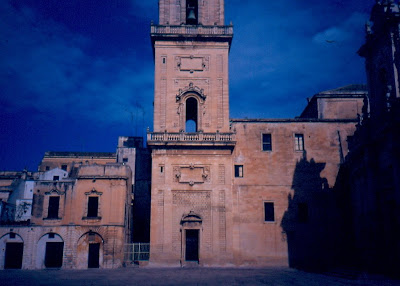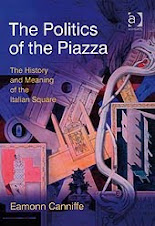-
Saturday 31 October 2009
Piazza in Film 16: Piazza della Repubblica, Rome
from the film Risate di Gioia (1960) with Anna Magnani
Friday 30 October 2009
Wednesday 28 October 2009
Tuesday 27 October 2009
Contemporary Architecture and the Legacy of Piranesi
Some of the most significant architects of our era have cited designer and architect Giovanni Battista Piranesi's influence on their work. Peter Eisenman, Michael Graves, and Robert Venturi, are inspired by Piranesi's eclectic and imaginative approach to his designs. Stan Allen moderates the discussion.
Monday 26 October 2009
Sunday 25 October 2009
Saturday 24 October 2009
Friday 23 October 2009
Thursday 22 October 2009
The Imposition of Order: Autocracy and Architectural Expression in two North Italian piazze
Wednesday 21 October 2009
Tuesday 20 October 2009
Monday 19 October 2009
Sixtus V, Domenico Fontana and the Replanning of Rome

As is well known, in 1585 pope Sixtus V charges Fontana with restructuring the city of Rome as a part of the counter-reformist agenda of the Catholic Church. In the period of five years -— for Sixtus's papacy turned out to be that short -— Fontana succeeds in doing something which today we might describe as re-inventing the city. His vision, unmistakably revealed in a well-known drawing, no longer deals with the city as a static, controlled object . Rather, the city is conceived of as a network. Urban spaces become nodes, identified by the vertical markers of obelisks and columns, and these are tied together with a web of straight streets, "tunnels of vision" intended to drive one onward to the next nodal space.

Fontana's intervention is amply documented and discussed in the literature, but the significance of his conceptual leap is not. For example, as late as 1963, such a respected historian as Henry Millon would write that "we have yet to have a clear picture as to what Fontana and Sixtus the Fifth intended with their streets and obelisks 6." Yet the consequences of Fontana's and Sixtus's work for a new idea of the city seem apparent. First, operating on the city is not an activity in which all the elements of a spatial composition are controlled, as they would be in a building, but an undertaking in which a hierarchical framework functions as the structure for incremental development, growth, and change. Second, the intimate connection between city shape and movement flow becomes the generator of urban form, intended to respond to the increasingly pressing need to communicate and transport, not just to be an assemblage of spaces. And finally, the realization begins to emerge that the city, because of its complex nature, requires new rules and structures that can manage both its administrative and spatial aspects.

This conception is not independent from architectural control of elements and spaces woven into the urban network. On the contrary, architecture provides the means by which nodes and connections acquire spatial presence, as the great squares of baroque Rome illustrate.
Fontana's brilliant intuition foreshadows a conception of the city that increasingly reflects reality in today's world.
Extracted from
Guido Francescato City as Home and City as Network: Contrasting Paradigms in History
Sunday 18 October 2009
Urban Theatricality: Teatro Olimpico, Vicenza
Andrea Palladio and Vincenzo Scamozzi's scenae frons at the Teatro Olimpico in the opening sequence of Joseph Losey's film of 'Don Giovanni'.
Saturday 17 October 2009
Friday 16 October 2009
Mannerist Interventions: Three Sixteenth Century Italian Squares


















A study of Piazza degli Uffizi, Florence, Piazza Maggiore, Bologna, and Piazza Grande, Arezzo published in Urban Design Studies: Annual of the University of Greenwich Urban Design Unit Volume 1 1995
Subscribe to:
Posts (Atom)











































